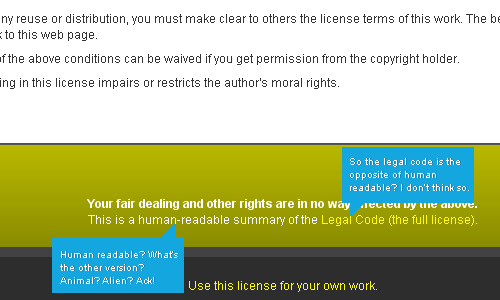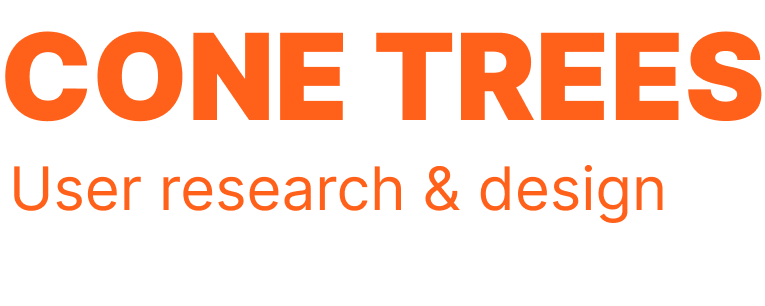Summary
When communicating with your users, avoid using unnecessarily complex words or system oriented terms. Use simple language that will be easily and immediately understood by your users.

After discussing about the usability issue with Creative Commons licensing at Flickr , we shift focus to a minor issue at Creative Commons that none the less highlights the importance of using simple and correct language instead of using unnecessarily complex language to communicate with our users.
What is the issue?
The footer of the Creative Commons licenses state “This is the human-readable summary of the Legal Code”. The issue is using the word “human-readable”. Why this is an issue is explained below.
Why is this an issue?
- The word ‘Human-readable’ has been incorrectly used. ‘Human-readable’ means “information that can be read by humans” as opposed to ‘machine-readable’, which means information that can be read by machines or computers, e.g- bar codes and XHTML code.
Unfortunately, Creative Commons uses it to signify the opposite of legal code, which is incorrect. ‘Legal code’ is also in fact ‘human-readable’ (unless you think of the legal guys machines or robots, or birds… Legal eagle?). So for those users, and I would assume there would be many, who don’t know the meaning of it and try putting two and two together, Creative Commons actually ends up teaching how to use the word incorrectly.
An example of the correct usage of the term ‘human-readable’ (taken from the Microformats Wiki) would be, “Microformats are a way of adding simple markup to human-readable data items such as events, contact details or locations, on web pages, so that the information in them can be extracted by software and indexed, searched for, saved, cross-referenced or combined.”
The statement above signifies the fact that Microformats can be understood by both humans and machines/ agents, or in other words, it is both human-readable as well as machine-readable. - It’s also an unnecessarily complex term and can easily be replaced with a simpler word to communicate with the user more effectively. When you use language that consists of either complex words, you are only increasing the time it will take for your users to comprehend what you are trying to say. You’ll also end up with a number of users who will not understand you at all, leaving them frustrated or disappointed at various levels.
What’s the solution?
In this case, it would have been more effective to state “This is the summary of the Legal code in simple language ” or “This is the summary of the Legal code in plain language” instead of “This is the human-readable summary of the Legal Code”.
Having said this, Creative Commons does not take any serious hits for using the term the way it has since it’s not used it anywhere as link text. Secondly, it’s used in the footer to simply state that this page is the plain language version of the legal code. But it’s still a term used incorrectly and unnecessarily. Using unnecessarily complex words only makes sense if you’re making a video game or a running a Star Wars fan club really.
A long ending note
Simple or plain language is not important if you don’t want all your users users to understand you.
Using complex language- A usability Issue
Users use your product to accomplish certain goals. If they need to understand what you’re trying to say in order to partially or completely accomplish those goals, but unfortunately can’t follow since you think the words you use are used and understood by everybody else, then a portion of your users will:
- Either take time to figure it out and will finally understand what you’re trying to say
- Or not get you at all
In both cases, you are disappointing users (who don’t understand what you mean easily) at varying levels since you are either increasing the time it will take for this particular segment of users, who don’t understand what you’re saying, to accomplish their goals or completely preventing them from accomplishing their goals.
In support of using simple language, Nielsen’s second usability heuristic states:
Match between system and the real world
The system should speak the users’ language, with words, phrases and concepts familiar to the user, rather than system-oriented terms. Follow real-world conventions, making information appear in a natural and logical order.
Let’s take a simple example. Take the words ‘expedite’ and word/ phrase ‘quicken/speed up’. Both mean the same thing. Ask 10 random people who have a varying command over English on what these words mean. You might guess that the ‘quicken/ speed up’ will be understood by more (or all) users than ‘expedite’.
Using complex language- an accessibility Issue
As mentioned in Calyton Lewis’ presentation on Cognitive Impairment & Accessibility
Studies suggest that many barriers to cognitive accessibility are the same as usability problems for a general user audience… but more severe
The W3C also states in the WCAG 1.0 (Web Content Accessibility Guidelines) as guideline 14.1:
Use the clearest and simplest language appropriate for a site’s content. (Priority 1, which means a web developer must satisfy this checkpoint since it is a basic requirement for some groups to be able to use Web documents.)
And in WCAG 2.0 (working draft), it’s one of the conditions you must satisfy to meet checkpoint 4.1. Section 4.1 is ‘Write Clearly’ (yes, that’s it).
Simple language is referred to as ‘Controlled language’ and is stated as:
Controlled languages use a restricted vocabulary taken from natural language. The purpose is to make texts easier to understand and translate. Standards generally limit words to a single meaning and prescribed part of speech. Complex syntax is avoided. Information about controlled language applications is available on the World Wide Web.
Benefits (informative)
- All users, especially those with cognitive, learning, and/or reading disabilities benefit from the use of clear and simple writing. This should not discourage you from expressing complex or technical ideas.
- Using clear and simple language also benefits people whose first language differs from your own, including those people who communicate primarily in sign language.
What’s your take on using unnecessarily complex language?
Have you ever been confronted by text that was unnecessarily written in complex language, or even worse, seen words used incorrectly in the process of trying to sound complicated?


Leave a Reply